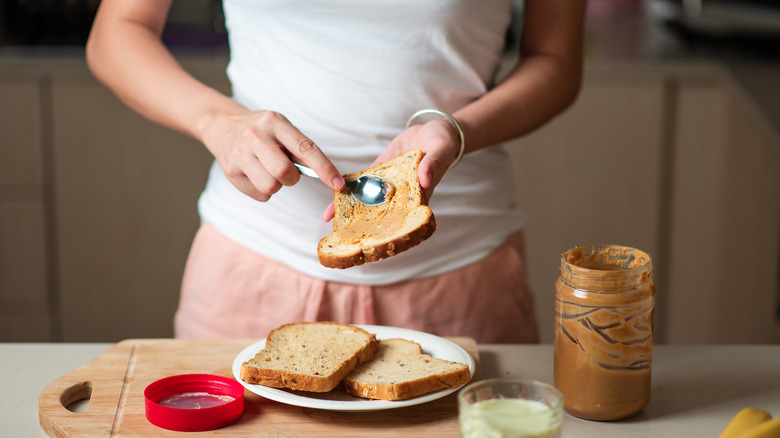What It Means When Eating Peanut Butter Gives You Acid Reflux
You might find it difficult to go to someone's home and not find a jar of peanut butter in their pantry. This popular protein-packed breakfast staple comes in a variety of different packaging and textures: crunchy, smooth, and even organic. It's one of the few sweet-tasting spreads that health experts recommend you add to your diet for a number of reasons, like the healthy fat and fiber content that supports cardiovascular health and reduces the risk of diabetes and the antioxidants and vitamins that ward off chronic diseases like cancer. When you eat peanut butter every day, you're also giving your body a good dose of protein for muscle health, zinc for good immunity, and phosphorus for healthy bones and cells, per Medical News Today.
Although peanut butter is generally considered safe for people who have acid reflux or gastroesophageal reflux disease (GERD), there might be times when eating some makes you feel like there's a backward flow of stomach acid in your esophagus. This could be triggered by the fat content in the nut butter, per Medical News Today. You will find about 3.3 grams of saturated fat, 8.29 grams of monounsaturated fat, and 4 grams of polyunsaturated fat in two tablespoons of the stuff. High-fat foods (particularly saturated fat) can be problematic for acid reflux, especially if portion sizes aren't controlled.
You could also be reacting to the additives in peanut butter
Just because the name on the bottle reads "peanut butter," that's not all that goes into making this tasty breakfast spread. And sometimes, what's causing your acid reflux might be the additives and preservatives in the stuff, per Tastylicious. The added salt, sugar, and oil (particularly palm or coconut oil) content in peanut butter can trigger acid reflux, per Medical News Today.
Plus, even though peanut butter isn't usually unsafe for those with acid reflux, it's still considered an acidic and non-alkaline food. It's rated as slightly acidic, with a pH reading of 6.3. With conditions like acid reflux, the recommended foods to include in your diet are alkaline options like bananas, melons, and cauliflowers, and nuts like almonds and chestnuts (as peanuts and walnuts are more acidic than the rest).
So, what does this mean for people with acid reflux or GERD symptoms?
How to eat peanut butter if you have acid reflux
You may want to start off by looking for the organic kind when you shop for peanut butter. Read the labels carefully and pick ones free of additives like sodium, sugar, and oils.
Experts also recommend choosing the creamy or smooth kind of peanut butter, as the chunky spread could cause some gastrointestinal discomfort. You can try combining the nut butter with alkaline foods such as bananas, vegetables, or regular wholegrain bread to see if this makes a difference (via Medical News Today).
And one of the most important tips if you're worried about acid reflux is to refrain from eating too much peanut butter. One or two tablespoons is the recommended daily intake anyway, but you can adjust this measurement based on how you feel after having some. Also, try to keep track of what else you're consuming for that particular meal or during the day to see if something else could be triggering your acid reflux instead. If you are almost sure it's the peanut butter, discuss this with your healthcare provider. You may have to limit or avoid consuming peanut butter altogether.



